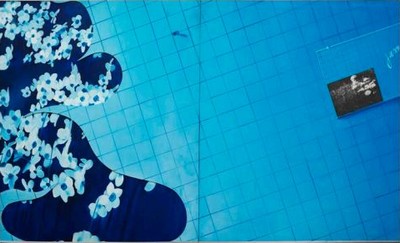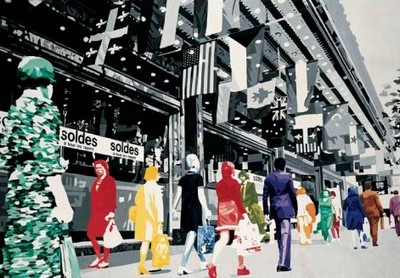Narrative Figuration 60s - 70s
Valerio Adami, Eduardo Arroyo, Erró, Gérard Fromanger, Jacques Monory, Bernard Rancillac, Peter Saul, Hervé Télémaque, Cybèle Varela
Richard Taittinger Gallery, New York
March 13 - May 16, 2021
Jamais plus les fleurs... 1969
Mixed media on wood
47.2 x 94.4 x 1 in. / 120 × 2 40 x 5 cm.
Former private collection of Gérald Gassiot-Talabot
Courtesy Richard Taittinger Gallery
Au printemps ou la vie à l’endroit 1972
59.0 x 78.7 in. / 150 x 200 cm
Courtesy Richard Taittinger Gallery
Richard Taittinger Gallery presents NARRATIVE FIGURATION ‘60s – ‘70s, the first comprehensive New York exhibition on the Narrative Figuration movement from Paris. This exhibition features the work of nine prominent international artists associated with the Narrative Figuration movement, who were active in Paris throughout the 1960s and 1970s: Valerio Adami (b. 1935), Eduardo Arroyo (1937-2018), Erró (b. 1932), Gérard Fromanger (b. 1939), Jacques Monory (1924-2018), Bernard Rancillac (b. 1931), Peter Saul (b. 1934), Hervé Télémaque (b. 1937), and Cybèle Varela (b. 1943).
This historical exhibition coincides with the 6th anniversary of Richard Taittinger Gallery, and has been curated by Richard Frerejean Taittinger in collaboration with Yoyo Maeght, a longtime partner and friend of the gallery.
In the 1960s, a new figurative style emerged in a tense international climate: the events of the Cold War, the Algerian War, and the Vietnam War gave rise to shocking images in the press. Simultaneously, the advertising images of a consumer society continued to multiply, alongside the frenzy and effervescence of artistic activity around the proliferating visual production of the era (cinema, video art, comics, Pop Art and New Realism).
On June 19th 1964, Robert Rauschenberg received the International Grand Prize for painting at the 32nd Venice Biennale, which celebrated the triumph of the American Pop Art movement on the international artistic scene, with New York replacing Paris as the new art capital of the world.
As a reaction to American Pop Art hegemony, French art critic Gérald Gassiot-Talabot, together with young painters Bernard Rancillac and Hervé Télémaque, organized the Mythologies Quotidiennes exhibition at the Museum of Modern Art of the City of Paris in July 1964, signifying the beginning of the Narrative Figuration movement, and becoming a de facto manifesto for the movement. Thirty-four artists participated in Mythologies Quotidiennes (including Eduardo Arroyo, Jacques Monory, Bernard Rancillac, Peter Saul and Hervé Télemaque), each coming from different stylistic and geographical backgrounds.
Like their American counterparts, the artists placed contemporary society and its imagery at the heart of their work; however diverged from them by rejecting a certain “art for the sake of art.” Indifferent to American Lyrical and Gestural Abstraction, and hostile to the Abstraction of the School of Paris, Narrative Figuration artists rejected the clinical coldness of American Abstraction and the emptiness of Pop Art in the 1960s and 1970s. As Gérald Gassiot-Talabot proclaimed, “to the static derision of American Pop, they ‘all’ oppose the precious movement of life.”
The artists showcased in NARRATIVE FIGURATION ‘60s – ‘70s rejected the mechanization of painting and challenged the fetishization of consumer goods. They pushed against rigid academic constraints and pulled tools from Academic, Pop and Abstract movements while centering cultural and humanitarian concerns in their work.. The work of these artists in NARRATIVE FIGURATION ‘60s – ‘70s varied stylistically, but found cohesion in underground anti-conformist ideology and emotional authenticity.
Gérard Fromanger, Erró and Cybèle Varela became involved in the Narrative Figuration movement after the Mythologies Quotidiennes exhibition, and the movement gained traction in the late 1960s. This heightened momentum slowed and the movement eventually disbanded in the late 1970s, each artist building on their solo career.
The insurrectional events of May 1968 in Paris became a peak of the political production and involvement of some of the artists of the Narrative Movement, most notably Gérard Fromanger, Eduardo Arroyo and Bernard Rancillac. Gérard Fromanger was a co-founder of the Atelier Populaire de l’Ecole des Beaux-Arts and he involved himself in the protests by creating his most controversial work, Album the Red of 1968, consisting of 21 serigraphs of communist and capitalist nations’ flags dripping in blood.
Eduardo Arroyo, born in Madrid, Spain during the Spanish Civil War, was forcibly exiled from Francoist Spain, becoming a political refugee in Paris in 1958. His work questioned the role of the artist in society, using painting as a militant weapon, and he contributed to the production of prints at the Atelier Populaire des Beaux-Arts.
Bernard Rancillac participated alongside him, two years after eighteen canvases of his were displayed at the Galerie Blumenthal-Mommaton, each of which provided social commentary on the political and significant events of 1966, including the Vietnam War, Apartheid in South Africa, and the fight for contraception.
Valerio Adami, born in Bologna, Italy, and Hervé Télémaque, born in Port-au-Prince, Haiti, were both artists whose language was less accessible than that of their counterparts. The formal representation of flattened forms and highly stylized planes of Valerio Adami, simple at first, require sufficient intellectual research to gain insight into their meaning. Télémaque created assemblages of drawings, paintings, glued papers, and recovered or invented objects influenced by his daily life and memories evocative of Haiti, with socio-political undercurrents, however unlike the evocative and explicit work of Erró, Saul, Rancillac and Monory, his subjects rendered themselves less identifiable, allowing or inviting the viewer to make the narrative connections in his work.
Each artist involved in the movement drew imagery from popular culture, however Jacques Monory, Erró and Peter Saul are the most likely to be categorized as Pop artists. Jacques Monory has said; “What has developed in France has moved away from American Pop Art. We have expressed a critical narrative of society while the Americans have almost always, in my opinion, embraced their system.” Jacques Monory’s works observe the contemporary world and represent the violence of our everyday life. Cars, firearms, animals and sensual female figures obsessively appear, constituting both observation of places in the modern universe and a repertoire of the fantasies of the artist.
Erró, born in Ólafsvík, Iceland, moved to Paris in 1958. He gained an international reputation for his political paintings. He employs the comic book style of the Pop Art movement, however, his works are rooted in the tense international climate of the 1960s. The Cold War, the War of Algeria, and the Vietnam War were very influential, as they are in the work of Peter Saul.
As early as 1962, Peter Saul amazes with his parodic representations where self-mockery, humor, aggressiveness and scabrous subjects mingle. He embraced the challenges of the Hippie movement and made his painting a political weapon - thus joining Arroyo and Rancillac.
Cybèle Varela, born in Petrópolis, Brazil, has been historically overlooked in the previously underresearched discourse of the Narrative Figuration movement. A feminist pioneer and a prominent figure in Brazilian Pop Art and Tropicalismo, Cybèle Varela left Brazil in 1971 as a result of the military dictatorship and, like Arroyo, moved to Paris, where she became involved in the Narrative Figuration movement. This exhibition seeks to pay tribute to Cybèle Varela as the last living woman involved in Narrative Figuration since the 1970s, who has recently signed representation with the Richard Taittinger Gallery.
The Parisian countercultural narrative of the 1960s has resonance in contemporary New York City, following the acclaimed first US solo exhibition JACQUES MONORY at the Richard Taittinger Gallery in 2018.
RICHARD TAITTINGER GALLERY
154 Ludlow Street, New York, NY 10002


